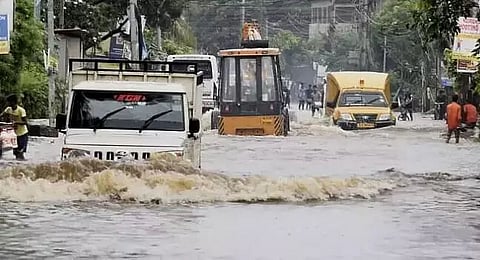
- Home
- Live Blog
- Breaking News
- Top Headlines
- Cities
- NE News
- Sentinel Media
- Sports
- Education
- Jobs

STAFF REPORTER
GUWAHATI: In yet another grim repeat of the monsoon nightmare, large parts of Guwahati remain submerged after incessant rains, raising serious questions over the effectiveness of the much-publicised Mission Flood-Free Guwahati (MFF). Residents wading through knee-deep water, stranded vehicles, waterlogged roads, and overflowing drains have once again become the unfortunate norm—despite the crores of rupees spent and years of promises made under the ambitious initiative.
Launched as a coordinated, multi-departmental mission to end urban flooding in Assam’s largest city, the MFF project had enlisted a plethora of agencies—Guwahati Municipal Corporation (GMC), Guwahati Metropolitan Development Authority (GMDA), PWD, WRD, NHAI, OIL, Northeast Frontier Railway (NFR), and APDCL—to collectively tackle the flood menace. The plan involved desilting major rivers like Bharalu, Bahini, Basistha, and Mora Bharalu, as well as the reconstruction and cleaning of hundreds of city drains, culverts, and stormwater lines.
While significant work reportedly took place in 2023 and especially in 2024—with officials citing the cleaning of 143 major drains, road-cum-drain reconstructions, and even the diversion of stormwater from the Meghalaya hills—this year’s floods tell a different story.
“The assigned job for all the departments is almost completed. In some cases, it’s on the verge of completion,” a senior official told this reporter. “Everything was done, and waterlogging should not have happened, so it is a new learning, and a new strategy is being chalked out.”
However, those assurances ring hollow for the residents of Anil Nagar, Nabin Nagar, Hatigaon, and many other low-lying areas, who once again find themselves bailing out homes, missing work, and losing property. For them, the Mission Flood-Free has become Mission Failed.
“It’s the same every year. They say drains are cleaned and rivers are desilted, but the water has no place to go,” said Anuradha Saikia, a resident of Rukminigaon. “We hear of so many departments being involved. But where is the coordination?”
Critics argue that the real issue lies not in effort but in execution and urban planning. “There is no proper drainage system in the city, and whatever footpath and drain constructions are happening now are largely unplanned,” admitted an official source. “An underground drainage and sewerage system has to be installed in the middle of the road, but after constructing flyovers, that’s become nearly impossible.”
In areas like Pub Sarania and Basistha Chariali, officials conducted gradient surveys and installed pumps—but these localised fixes have failed to bring systemic relief. Experts now warn that piecemeal approaches won’t work for a city as complex as Guwahati, which deals with unique topography, rapid urbanisation, and stormwater inflows from adjoining hills.
In a possible shift in approach, a GMDA official revealed that a comprehensive master drainage plan is finally being draughted. “After the plan is made, a new drainage system will be constructed in Guwahati. But for the time being, Mission Flood-Free looks like it is impossible.”
As the city battles yet another spell of flooding, frustration is mounting among citizens, activists, and urban planners alike. While Guwahati continues to drown every monsoon, the MFF mission—despite its scale and ambition—is struggling to stay afloat.
Also Read: Guwahati Flood Solutions: EcoBlock and Drain Projects Initiated
Also Watch: